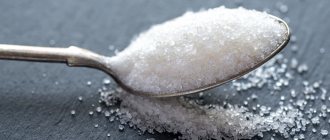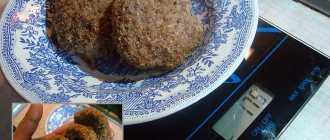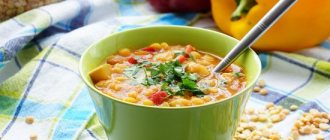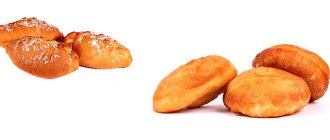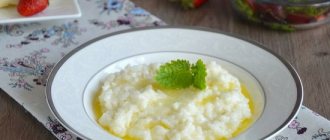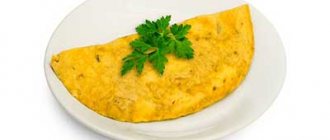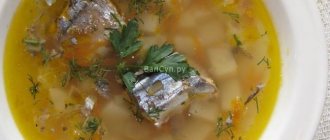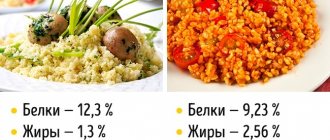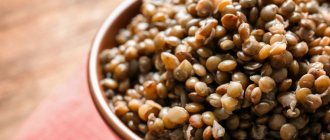In the last article, we learned about the calorie content of Chinese cabbage and now we can use this product against excess weight! Today, we are interested in a rather controversial topic - the calorie content of boiled rice. Is this dish effective for losing weight and healing the body? Let's figure it out together.
Rice is one of the most popular grains in the world! Without it, it is unimaginable to imagine Indian, Thai, Japanese and other cuisines. In many countries, rice is not called “bread” for nothing. At the same time, boiled white rice is often used in cooking not only as a side dish, but also as a main dish or ingredient.
Boiled white rice can have different textures, shapes and lengths. All this, of course, depends on the variety and type of cereal. Boiled white rice can be stored on the refrigerator shelf for up to five days. However, it will bring great health benefits if consumed immediately after preparation.
Rice: beneficial properties and contraindications
- Boiled rice, the calorie content of which certainly allows it to be included in diet menus for health improvement and weight loss, is rich in natural fiber and starch.
- And complex carbohydrates in the product are considered the most useful.
- It is these carbohydrates that can provide our body with the necessary charge of energy and not remain in the body as a fat layer.
- Doctors recommend rice dishes and diets for people suffering from diseases of the cardiovascular system and kidneys.
This dish in any of its manifestations is not recommended for regular consumption by those who suffer from constipation and diabetes. Just like potatoes, the calorie content of which we reviewed in this article!
Benefits of white rice
The rhythm of modern life and the changing food market force us to choose ingredients for our menu more carefully. We care about the health of our loved ones, we want to maintain our physical fitness, and reduce the risks of heart attacks, which young people are also susceptible to today. In this context, we will consider the use of white polished rice.
For weight loss
How effective is white rice for weight loss? Let us note the main factors that give the right to include rice in the menu of those losing weight: complex carbohydrates quickly fill you up, and the low calorie content helps you stay in shape.
We remember that 100 g of boiled rice contains only about 120 kcal. When creating a menu with a calorie content in the range from 1200 to 1800 kcal, you can include a side dish of rice or vegetable pilaf (150-200 g). But the final calorie content of dishes depends on the method of preparation and all other components. For example, a fried pork chop with a side dish of boiled rice will not help you lose weight. Experts recommend creating nutrition programs, choosing simple and healthy ways to process foods: baking, boiling, steaming.
Important! When preparing the grain (grinding and removing useful shells), white rice loses biologically active substances, which are especially valuable in a sports diet. In fact, it turns into a piece of starch. And to lose weight, it is better to replace it with healthier types of grains - brown or black rice.
Rice is included in several popular diets. However, remember that mono diets have limitations and are not for everyone. A nutritional program based only on boiled rice will give quick results, but the results may be short-lived.
Weight loss with white rice occurs not because of its beneficial properties, but because of the gross limitation of other substances in the diet: fats, protein, vitamins. Such experiments should be abandoned in case of any disturbances in the gastrointestinal tract or increased physical activity. For healthy people, fasting “rice” days and including properly prepared white rice in the diet will bring benefits and visible effects. Especially if you combine nutrition with walking, swimming, yoga or fitness.
For the prevention of diseases of the heart, nervous system, etc.
100 g of rice contains almost 300 mg of potassium, which gives reason to pay attention to the product for everyone who is susceptible to diseases of the cardiovascular system.
In addition to potassium, calcium and iron, which are useful for the functioning of the heart, rice has a unique property: it absorbs excess liquid and salt, which improves the condition of blood vessels, corrects kidney function, and relieves edema.
It is worth noting the positive effect of using rice for diseases of the nervous system: B vitamins, lecithin and tryptophan activate metabolic processes and strengthen the nerves.
The benefits of rice for the prevention of Alzheimer's disease have been proven: the combination of vitamins and amino acids keeps the nervous system in good shape, activates mental activity and slows down the development of senile dementia.
Please note that these benefits are relative. If the choice is between fried potatoes in lard and boiled white rice, then you should choose porridge. In all other cases, the benefits of eating steamed rice, brown or black, will be much higher!
For the work of the gastrointestinal tract
If you have stomach problems, you should introduce slimy porridges into your diet. One of them is rice. Boiled glutinous rice is useful for people with gastritis or ulcers: the porridge will create a soft membrane on the walls of the esophagus, protecting them from irritation.
In case of poisoning, stomach upset (including infectious diseases), a rice diet will help quickly normalize stools, cleanse the body of toxins, and restore intestinal microflora.
A cup of boiled rice with baked fish or lean meat will not only be a complete meal, but will also help cleanse the intestines. But remember the rules for preparing the product, try to correctly combine ingredients in dishes and not overeat.
Boiled rice: composition
Properly cooked white rice retains most of its beneficial properties. Chemical composition of boiled rice: sodium, phosphorus, iodine, iron, zinc, calcium, potassium.
This product is also rich in vitamins, which are represented by the following list: vitamin PP, H, E, D, B6, B5, B2, B1.
Chemical composition of rice
The most common is white rice. It includes:
- micro- and macroelements;
- polyunsaturated and saturated fatty acids;
- alimentary fiber;
- mono- and disaccharides;
- vitamins.
Content of substances in rice
| Element | Content per 100 g, mg | Share of daily value in 100 g, % |
| Potassium | 314 | 1,8 |
| Manganese | 1,1 | 47,8 |
| Phosphorus | 108 | 15,4 |
| Zinc | 1,2 | 10,5 |
| Magnesium | 35 | 8,8 |
| Copper | 0,1 | 12,2 |
| Iron | 0,8 | 8 |
| Sodium | 7 | 0,7 |
| Selenium | 0,015 | 28 |
| Chromium | 0,002 | 3,4 |
| Fluorine | 0,05 | 1,3 |
| Molybdenum | 0,003 | 4,9 |
| Cobalt | 0,001 | 10 |
| Iodine | 0,015 | 0,9 |
| Chlorine | 25 | 1,1 |
| Silicon | 100 | 333 |
Rice grains are a source of not only minerals, but also vitamins:
- group B;
- RR;
- E;
- N.
Most foods contain only a few vitamins and minerals in limited quantities. Therefore, it is important to formulate a diet so that the body receives food of different composition. Before including rice on the menu, BJU should be calculated. It saturates the body with carbohydrates; there are few proteins and fats in its composition.
The special chemical composition of both white and brown rice grains has a beneficial effect on the functioning of the cardiovascular, immune, and nervous systems. Under their influence, the functioning of the digestive organs is normalized, excess fluid and toxins are removed from the body. This helps cleanse the kidneys and liver, improves the water-salt balance in the body.
Due to its high starch content, rice cereal is considered a good source of energy.
But the amount of this substance in the composition is directly related to the type of grain. Long-grained varieties have minimal starch content. When cooked, the grains do not stick together, the porridge or pilaf remains crumbly. Medium and fine grain varieties have more starch, which is why they produce sticky rice porridge.
We recommend that you read: The difference between white and red beans
Rice contains dietary fiber, which has a positive effect on digestion. In 100 g of dry grains they are contained in the amount of 2.9 g. This is enough to cover 14.5% of the daily requirement.
Main types of rice
Also, the calorie content of boiled rice differs (albeit sometimes insignificantly) depending on the type of cereal.
The most common in cooking are:
- Oval grains up to 5 mm long. They usually have a more round shape, which is why they are often called “round”. This low-calorie boiled rice exhibits its taste best in puddings, casseroles and milk porridges. This type of rice is distinguished by its creamy structure, stickiness, and softness of the grain.
- Medium grains up to 6 mm, characterized by a larger width. During cooking, this type of rice absorbs a lot of liquid, sticking together and becoming soft. This product is best used for making paella or risotto.
- Long grains up to 8 mm in length, absorbing a moderate amount, due to which this type of rice cooks much faster than the ones described above. This harsh type of cereal is best suited for making desserts, salads, appetizers and first courses.
If you want to learn more about how to use the calorie content of rice to correct your figure, watch the video!
Rice based diets
Rice-based diets are divided into soft and hard . It is recommended to go on a strict rice diet rarely and only in case of urgent need (and better yet, never).
Strict diets most often last 3 days and involve the consumption of boiled cereals (1 glass of dry cereal per day) without adding salt, pepper, other spices and additives. This diet can be diluted with natural juices.
There are options for extending this diet . For example, for 3 days they eat exclusively rice, on the 4th day they allow themselves fruit or chicken breast, then again they return only to cereals.
Milder diet options are rice, vegetables, chicken or rice, vegetables, fruits, chicken. Such diets most often last no more than ten days. The daily diet looks something like this:
- breakfast – rice with water (do not add salt);
- lunch – boiled rice with chicken breast;
- afternoon snack - orange;
- dinner - boiled cereal without salt.
The diet may vary depending on the specific diet and day of the week.
A nine-day diet is also popular , when the first three days they eat cereal, the next three days - chicken in its various variations, and the last three days - vegetables and fruits in any form.
Important! There are many variations of diets with rice as the main ingredient. One thing remains unchanged: any strict diet is stressful for the body, so you should create a menu wisely, and it is better to consult with a specialist before doing so.
Low-calorie rice in cooking
- As noted, the calorie content of boiled rice with salt allows it to be used for preparing daily dishes.
- Fortunately, there are, if not millions, then thousands of recipes with it. White rice is considered an ideal product for making casseroles, puddings, snacks, pancakes, salads, soups, and cereals .
- Quite often, boiled rice is also used to fill meat rolls, cabbage rolls, stuffed peppers and poultry.
How to properly cook fluffy rice in a saucepan?
However, in order for the cooked rice dish to please your taste buds without causing disappointment, you must follow some rules when preparing it.
Here they are:
- Every time before cooking rice cereal, be sure to rinse it several times;
- In order for the finished rice to be crumbly, it is necessary to cook it based on a 2:1 ratio (two parts water to one part rice);
- In order not to constantly disturb the rice during cooking, you should take a container with thick walls and a bottom;
- It is recommended to cook white rice over medium or low heat after boiling;
- Always cook rice covered, this way you will avoid losing the moisture needed for cooking;
- After all the liquid has been absorbed into the cereal, you need to taste it to determine the degree of readiness.
Boiled white rice, the calorie content of which our dear readers are interested in, also has remarkable absorbent properties. It is not surprising that it is most often used to cleanse the body. More on this later.
Calorie content of brown rice
Brown rice differs from white varieties in the method of pre-processing. Only the inedible hard husk is removed from the grains without damaging the structure of the grains. This variety is popular in Europe and Asia. The local population uses it to prepare not only first and second courses, but also bread, pies, pancakes and wine.
The cereal contains a large number of biologically active compounds, fat-soluble vitamins and oils. The inner endosperm contains starch and cellulose. Detailed composition:
- zinc - 2.3 mg;
- manganese - 2.1 mg;
- iron - 2.3 mg;
- sodium - 7.1 g;
- calcium - 12.2 mg;
- magnesium - 90.6 mg;
- phosphorus - 201 mg;
- potassium - 200.6 mg;
- PP - 79 mg;
- E - 5 mg;
- A - 0.49 mg;
- B9 - 28 mg;
- B6 - 0.07 mg;
- B5 - 1.6 mg;
- B3 - 4.7 mg;
- B1 - 2 mg.
The concentration of substances beneficial to the body directly depends on the type of rice. The cereal also contains dietary fiber (up to 18 mg per 100 g). Dry brown rice, whose calorie content is 335-338 kcal, contains carbohydrates (up to 78 mg), fats (up to 2 mg) and proteins (up to 8 mg).
Due to the low hypoglycemic index, the cereal does not provoke glucose surges, so the cereal can be consumed by people suffering from diabetes.
Antioxidants present in the cereal prevent the formation of benign tumors. Regular consumption of this variety of rice allows you to normalize liver function, accelerating the removal of toxins from the body. Cereals are useful for people with weak intestines: with its help you can get rid of diarrhea.
People who regularly consume brown rice note that, as a stand-alone dish, the cereal quickly satisfies hunger and promotes weight loss, despite its high carbohydrate content. Cereals have a beneficial effect on blood vessels, preventing the formation of harmful cholesterol. Biologically active substances restore normal functional activity of the brain.
With regular consumption of brown rice, patients experience an increase in the body's resistance to stress.
It can be included in the diet of people suffering from gluten intolerance. Despite its low calorie content, the cereal provides a boost of energy and quickly satisfies hunger. Allergic reactions do not occur, so rice is given to elderly people and children. To preserve maximum beneficial properties, the cereal must be cooked correctly.
We recommend that you read Determining the ripeness of pineapples by appearance
Boiled in water
Brown rice absorbs less moisture during cooking than white rice. The variety is quite harsh, so many people refuse to use it. Cereal cooked without additives in water promotes weight loss and cleanses the intestines. Algorithm for preparing rice as an independent dish:
- pour 250 ml of cold water into a saucepan with a thick bottom;
- pour washed rice into it;
- cover with a lid and bring to a boil;
- reduce heat and cook the cereal for 35-40 minutes.
To maintain the structure of the grains, there is no need to stir the rice during cooking. The finished cereal turns out crumbly and retains a light nut aroma. Boiled cereal cannot be stored for a long time: it loses its taste 48-72 hours after heat treatment.
Rice is sometimes given time to absorb moisture. Unlike white varieties, brown ones cannot be poured with boiling water.
After washing it first, pour it into cool water and leave for 3-4 hours. This will reduce the cooking time by almost 2 times. Despite its low calorie content, you should not eat brown rice every day: it has an intense effect on the walls of the intestines and stomach.
With salt
Despite various additives (salt, vegetable oils, spices), the calorie content of boiled brown rice remains unchanged (no more than 112 kcal). During the cooking process, the cereal retains all its beneficial properties. The composition remains virtually unchanged. BJU ratio:
- carbohydrates - 25 g;
- proteins - 3 g;
- fats - 1 g.
You can add salt to the water regardless of the stage of cooking. To prevent the grains from sticking together, you can add a little vegetable oil (olive, sunflower) to the rice.
Boiled rice for weight loss
If you have ever been interested in fasting days, cleansing the body of waste and toxins, as well as losing weight, then you know that a diet based on boiled rice is a frequent guest there. Stars of the catwalk, cinema and music constantly talk about the effectiveness of this product in this area. On our website you can find a menu of such diets in the menu section of the same name.
Boiled rice diet
This is more likely not a diet, but a fasting day. After all, even nutritionists note that you cannot eat rice alone for more than 2 days because of its binding properties. Otherwise, you may harm your own health.
- For weight loss, we will use the calorie content of steamed boiled rice and the calorie content of boiled rice in water with salt.
- So, cook or steam porridge from 200 g of cereal and divide it into 5 equal parts. They will become our food for the day.
- It is best to eat portions at the same time interval (for example, every 3 hours).
- On such a day you can drink purified water, warm green tea and kefir. If you really want to eat, you can eat one medium green apple.
Application
The most common use of boiled white rice is as a side dish for meat or fish dishes. It goes equally well with sweet dried fruits and with mushrooms or pickles. It is added to stuffed vegetables or poultry and fried with vegetable mixtures. The now popular sushi and Japanese rolls are made from white boiled rice. Cooking rice is a process that requires attention. Before cooking, the rice is washed, preferably in several waters. Cook over medium heat, in a thick-walled container, this helps avoid burning. Short grain rice is better suited for making porridges due to its viscosity and stickiness. Long grain, on the contrary, remains crumbly after cooking.
Market Analytics
- Global cosmetics market 2021: an unprecedented test for the global cosmetics industry
- Top 10 Cosmetic Research and Development of 2021
- 2020 in the beauty industry – innovation without borders
Convenient search for beauty salons on our website
Beauty salons in Moscow Beauty salons in St. Petersburg Beauty salons in Ekaterinburg Beauty salons in Novosibirsk
Latest blog posts on our website
- Naturecream / Properties of the “Sunny” oil itself
- Naturecream / “Sugar” wrinkles - or what glycation can do
- Naturecream / Esterified oils
- Naturecream / Arnica - the magical plant of alchemists
- Naturecream / Tremella Extract - Snow Mushroom Detox for Skin
- Prostye-sovety / How to visually enlarge your lips with makeup
- Naturecream / Apricot kernel oil for face
- Naturecream / MATRIXYL3000 - the best skin elasticity stimulator
- Naturecream / SPF in Natural Oils
- Naturecream / Geranium (Pelargonium) oil for skin health and beauty
Latest forum topics on our website
- Natalya / How to properly make a gelatin mask?
- Mrs._Smith / Badly sunburned! What to do?((
- Ice / Is it necessary to combine fitness classes with a diet?
- Antonova / What can be used for hair loss?
- Radio operatorKat / Who was on a protein diet?
Other articles in this section
| Pearl barley porridge on water The “name” of this porridge comes from the English word pearl. Barley grains, after removing the top layer from them and polishing, are very reminiscent of pearls. After all, it is by grinding barley that pearl barley is obtained. Peter I especially appreciated the beneficial properties of this dish, even considering pearl barley to be the “queen of porridges.” |
| Oat bran Oat bran began to be eaten several decades ago, since its beneficial properties had not been studied before. Bran was considered a waste product from cereal production. |
| Cooked bulgur According to approximate and unproven historical data, bulgur has been eaten for about 4000 years. For several thousand years, this product has been in great demand in many countries, for example, in India, where people cannot imagine preparing main dishes without it. |
| Buckwheat porridge Buckwheat is a cereal obtained from seed buckwheat. Northern India is considered the birthplace of buckwheat, where it is called “black rice.” They began to grow it there more than 5 thousand years ago. In Russia, this plant is called buckwheat, because. It was brought to the Slavs from Byzantium in the 7th century. |
| Corn flakes Corn flakes are a popular product today, which has an interesting history of its “invention”. This happened at the end of the 19th century in the USA, when the Kellogg brothers, the owners of the sanatorium, decided to add cornmeal dishes to the diet of the patients of their establishment. They started preparing a dish from flour in the kitchen, but they urgently needed to leave for the city. Returning to the sanatorium, they were disappointed, because the flour dish had clearly deteriorated, and the dough had turned into lumps. They felt sorry for throwing away flour, so they rolled out the failed dough into small layers and fried them in oil. As a result, the resulting dish turned out to be extremely tasty: the flakes crunched pleasantly on the teeth, and with the addition of milk it was completely impossible to tear yourself away from them. This is how corn flakes were born. |
| Quinoa This grain grows in America, so you don’t often see it on sale, except in organic stores. This cereal contains a lot of vitamins and microelements, and is similar in composition to mother’s milk, as it is absorbed almost completely. |
| Buckwheat porridge from kernels As a food crop, buckwheat has been cultivated, according to various sources, for 2.5 to 5 thousand years. The birthplace of everyone's favorite porridge is the Himalayas, where the mild, humid climate contributed to the formation of valuable grains, and where even now wild buckwheat species are found. It came to Russia back in the 1st century AD, according to the famous cuisine historian Pokhlebkin, through Greek Orthodox monks, for which it received its “geographical” name. However, the widespread use of cereals in everyday nutrition began only in the 15th century, and over time it became one of the elements of national culture. In some Western countries, buckwheat porridge is known as “Russian”. |
| Triticale Triticale has become popular only recently. A completely new promising grain crop is the result of biotechnology and selection. This grain received its name by combining the Latin names of wheat and rye - “triticale” = “triticum” + “secale”. The new cereal has excellent production qualities, it is resistant to weather changes, has high yield potential, and is not picky about soil conditions. The increased level of grain immunity provides resistance to diseases and viruses. |
| Cooked brown rice Brown rice is not some kind of “supernatural” product. The rice grain is white in color and is encased in a unique bran “jacket.” Brown rice has a pleasant, rich taste and a subtle, nutty aroma. The consistency of the product is elastic and quite hard. |
| Brown rice In the 18th and 19th centuries in Asian countries, brown rice was considered the food of the poor; noble people preferred exclusively white product. The processing scheme for regular rice consists of removing the top hard layer of the harvested rice grains and removing the brown bran layer from the rice. When brown rice is processed, only the top layer is removed, while the second layer of bran remains intact. |
Cleansing the body with rice
This method of cleansing the body of toxins, waste and other harmful substances (salts, poisons, etc.) that enter it along with food and air is very convenient.
Let's look at the stages of preliminary preparation for cleansing the body with rice at home:
- Fill 3 kg of clean oblong rice with 10 liters of purified water;
- The next day, change the water and wash the rice thoroughly;
- We continue the above procedure for another 4 days. Until the liquid drained from the cereal is clear;
- Drain the water and dry the rice on the tablecloth. Then we pour it into a paper bag for storage.
And here, in fact, is the cleaning procedure itself. Every morning we cook porridge from one large spoon of prepared cereal and eat it. You need to cook without herbs, oil and spices. We continue to cleanse the body until the rice runs out.
For those who are afraid of gaining weight, let us say right away that the calorie content of boiled rice in water described above will not allow this to happen. But rice boiled with butter is sad because of its calorie content, so we don’t use auxiliary products.
Calories in red rice
Rice acquires its red hue thanks to anthocyanins, powerful natural antioxidants. The grains are covered with a dense shell, which contains a large amount of vitamins (PP, B, D, A), fiber and microelements (potassium, calcium, potassium, sodium, phosphorus). If you systematically, at least 2-3 times a week, eat this cereal, then:
- the functioning of the digestive tract and liver organs is normalized;
- blood sugar and cholesterol levels decrease;
- weight returns to normal.
For the first time, red rice was exported from Iran. The variety is popular in Asian countries. Red varieties are combined with many foods: it can be cooked with vegetables, mushrooms, lean meat or fish. To make the dish crumbly, you need to sort out the cereal before cooking.
It is poured onto a flat surface in small portions, whole grains are separated from husks, small stones and various fragments. After the cereal has been cleaned, it must be rinsed 2-3 times in cold water. Cooking time is 35-45 minutes. If you soak the rice in warm water for several hours, you can then cook it in 20 minutes.
During the soaking process, the cereal absorbs moisture in large quantities, so when cooking, add not 2-3 glasses of water to the pan, but 150-250 ml. Pour prepared rice into a container with thick walls, add cool liquid, add salt, vegetable oil or other spices. Place the pan over high heat and bring to a boil.
If foam forms, remove it with a spoon. After boiling, cover the pan with a lid and cook the rice over low heat. After the required amount of time has passed, you can try the side dish: if the grains are too hard, add a little water to the container and cook the dish for another 7-10 minutes. The calorie content of the finished product is 120-123 kcal.
We recommend checking out Braga on corn
Calorie content of boiled rice: what do those losing weight say?
- Valya , 18 years old: It’s been half a year since I taught myself to eat rice porridge with apples and dried fruits in the morning. After just a couple of weeks, I noticed a positive result: lightness and a surge of energy. It was as if I had been sleeping before. Here you have 100 g of boiled rice! The calorie content of the porridge is also pleasing, although it is not worth eating more than one portion per day.
- Inna Nikolaevna , 42 years old: I won’t speak for myself, since back in the Soviets we were accustomed to this product (pilaf, porridge, kharcho, cabbage rolls, etc.). But a friend regularly cleanses herself using the Tibetan method. He says that many of the sores have gone away and hormonal levels have returned to normal. But, for me, rice is still an indispensable product in the kitchen, although this year I will definitely try to go on a rice diet.
PS As you can see, Dear readers of the site “”, the calorie content of boiled rice is exactly the factor that can positively affect your figure and achieve the planned result!
What do you think about boiled rice? Share your recipes and healthy cooking techniques in the comments below!
Consumption rate
Rice is a product with a balanced composition . But if you use it frequently in large quantities, you can harm your health. Therefore, it is recommended to eat no more than 150 g of cereal per day.
Possible harm and contraindications
First of all, it is important to thoroughly rinse the cereal before cooking , since during production it is treated with harmful substances that are unsuitable for consumption.
Rice has a high glycemic index , which means that consuming it increases the risk of type 2 diabetes. Therefore, it is better to approach your diet wisely and alternate it with other cereals.
If you are watching your figure , then keep in mind that porridge is a high-carbohydrate product, which, when added with oil, salt and other additives, also becomes high-calorie.
Rice Density
If you don’t have scales at home, you can calculate how much rice cereal you need to take using data on the density of the product. This value is calculated as the ratio of body weight to the volume it occupies.
We recommend that you read Potatoes and hemorrhoids
Density of rice grains at a temperature of 0°C and an atmospheric pressure of 760 mmHg. is 750 kg/m³. This value is calculated for husked rice grains. Cereal has a lower density, it is 690 kg/m³. For unrefined grains - 680 kg/m³.
Taking into account the density, it was calculated that one 200 g glass can hold 150 g of rice, and a liter jar - 750 g. Knowing the volume of other containers, you can find out how many grams of rice they will contain. A 0.5 liter jar will hold 375 g of rice grains, and a 3 liter bottle will hold 2.25 kg.
Rice: BJU
When creating a menu, it is important to monitor the ratio of the amount of proteins, fats and carbohydrates that enter the body. Based on established standards, they formulate a diet. When creating a menu, many people are interested in whether rice is a carbohydrate or a protein.
This information is necessary to understand which products it can be combined with. It goes best with protein foods.
When eating rice, you should take into account that the calorie content of this product is high. But this is not its only drawback. Due to the ability of rice to absorb water in the body, digestion processes slow down. This leads to the absorption of nutrients in full.
The ratio of BJU in different varieties of rice varies slightly.
Protein content
White rice contains 6.7 g of protein per 100 grams of grains. With a standard caloric intake of 2000 kcal and compliance with USDA dietary recommendations, the body should receive about 90 g of this energy source daily. Every 100 g of rice grains provides 7.4% of the daily protein requirement.
Brown rice has slightly less than 6.3 g of protein.
The maximum amount of these substances is concentrated in the embryos and outer layers of the grain. There are few of them in the starchy part. The main protein component of grains is glutelin (orysenin). Its amount in different varieties varies from 68 to 82%. The content of alcohol-soluble proteins (prolamines) is insignificant. In the peripheral parts of the grains there are mainly albumins and globulins, and in the rest - oryzenins.
The amino acid composition is directly related to the varietal characteristics and conditions in which the grain crop was grown.
Rice proteins contain all the essential amino acids, but the amounts vary. For example, lysine content varies from 1.8 to 4.8%. Studies have shown that the composition contains glutamic, aspartic acids, methionine, and tryptophan. But the protein content in rice is low, so it is recommended to combine it with animal products. This combination increases the nutritional value of protein components.
We recommend that you read How to Preserve Pineapple at Home
Fat content
Rice is a low-fat food. In 100 g of white polished grains there are 0.7 g, brown grains with bran shell - 3.2 g. This amount covers from 1.5% to 7% of the daily fat intake with a standard caloric intake of 2000 kcal. But when calculating the ratio of BJU, the fats found in rice cereals should be taken into account.
Carbohydrate content
White rice is considered a high carbohydrate food. 100 g of grains contain 79 g of carbohydrates. This is almost 30% of the daily requirement. Therefore, people trying to lose weight should limit their consumption of rice. But you don’t have to give it up completely; you just need to supplement your diet with vegetables and protein foods.
Brown rice has a lower carbohydrate content, ranging from 65-72 g, depending on the type and growing conditions. But due to the large amount of dietary fiber, they are absorbed slowly.
Carbohydrates in rice include fiber, starch and sugars. White varieties contain quickly digestible carbohydrates. The starch contained in cereals is broken down into glucose when it enters the body.
The boiled product also contains its breakdown products - maltodextrins and dextrins. Due to their rapid solubility, they are absorbed faster than starch. The body processes carbohydrates from brown rice varieties more slowly. This is due to the increased fiber content in their composition.

